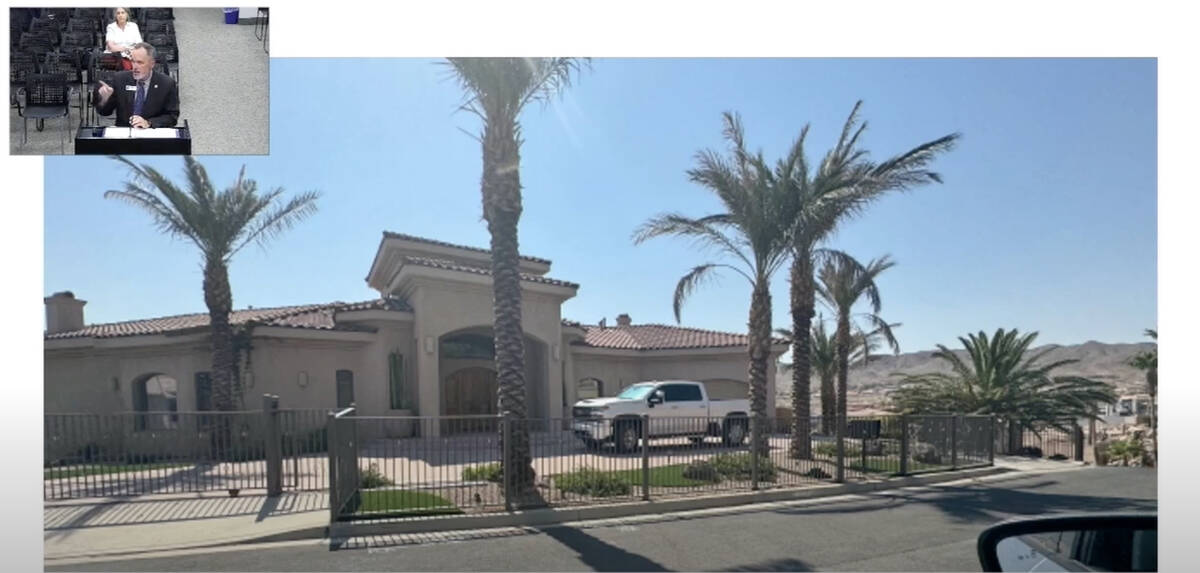
Getting a permit for something like a fence in your front yard may seem like a contrivance. Intrusive government and all that. But, here’s the deal, deciding to bypass that step may end up meaning you have to tear that fence out at your own expense.
That was the case last week as the city council voted unanimously to support a previous Planning Commission decision and to deny an appeal by the homeowners over a 4-foot high wrought iron fence across the front of their property.
Acting City Manager Michael Mays laid out the issue. “The property owner erected a 4-foot high fence within the right of way without a building permit.This was in violation of zoning requirements.”
The operative phrase there is “within the right of way.”
You may have landscaped and maintained your front yard right up to the curb, but that does not mean it is all your property.
In the case of this neighborhood overlooking Lake Mead, the setback, or the city’s right of way, is 9 and a half feet. Why? There are utilities buried underground that the city-owned utility may need to access in order to repair or maintain or upgrade them.
Mays explained, “The fence also blocks city access to the right of way and the utilities that are contained within it and that was a concern of our public works department because they would not have the ability to access the utilities if need be.”
The property owner submitted a variance request to be able to maintain the fence in its current location. That variance request was considered by the planning commission on July 17 and they ruled 7-0 to deny the variance. The property owner has the right to appeal the commission’s decision and that is why this matter was before the council last week.
Mays was asked what happens if the variance was denied and he replied, “They will be required to remove the fence and get plants off of the utility that’s underground.”
Mays further said that the plants aren’t the concern, it’s the fence that’s blocking city access to the utilities.
Land use consultant Karen Richardson was hired by the homeowners and was seeking approval of the variance that was submitted for the existing wrought-iron fence.
“Initially,” she explained, “It wasn’t clear to the family that the fence in its current location wouldn’t be allowed because directly across the street from their house, is a block wall that is set at the back of curb and it was within the right of way when it was constructed. However that was solved a number of years ago by the family purchasing the right of way. But that’s the reason that they thought that their wrought-iron fence was was going to be acceptable is they didn’t know the exact conditions of the block wall in that right of way.”
Richardson said the primary purpose of the fence is to secure the front yard and the driveway and that the homeowners feel it is integral to the safety and privacy of their property.
She presented a compromise plan that would see the part of the fence that is at the curb being moved back but allowing two already-installed gates to remain in place.
Part of that plan included the homeowners posting a bond that would provide funding to pay for the removal of the fence should that become necessary at some point in the future.
City Attorney Brittany Walker addressed the bond. “The city hasn’t entered into that type of agreement that I’m aware of ever. I can’t speak to other jurisdictions and if they have that type of agreement. Certainly you can enter into an agreement for that type of thing, that’s definitely possible. I haven’t heard of it though.”
Mays pointed out that denying the appeal was the path of least resistance.
“I would also like to point out for council’s benefit that our code does require certain findings to be made for a variance,” he explained. “The planning commission has made findings. If the city council chooses to affirm the planning commission’s decision, they can use the planning commission’s findings. If the city council chooses to reverse or modify the planning commission’s decision, new findings have to be made. Essentially, the council has to consider whether there are exceptional or extraordinary circumstances or conditions applicable to the property or its intended use that do not apply generally to other property or classes of use in the same vicinity and zone. Number two, the variance is necessary for the preservation and enjoyment of a substantial property right possessed by other property in the same vicinity and zone but which is denied to the property in question. Number three, granting of such variants will not be materially detrimental to the public welfare or injurious to the property.”
Councilmember Cokie Booth appeared to sum up the general vibe of the council.
“I think it’s unfortunate that this fence was put up without a a permit so that you knew where the right of way should have been and my concern is if we allow one then we start a slippery slope of allowing somebody else to do it and then somebody else to do it and then we have a mess around Boulder City because I’m sure there’s other people that would like to have their fence right to the edge of the the street,” she said. “So that’s my biggest concern. That we start something that we can’t stop by allowing the variance.”
The council voted unanimously to accept the finding of the planning commission and deny the appeal, which means the homeowner will have to remove the fence at their own expense.